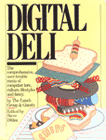|
Reviewed by Andy Molloy (first published in
Juiced.GS, Vol. 12 No. 4, December
2007)
A Digital Deli: The comprehensive, user-lovable menu of computer lore,
culture, lifestyles and fancy
Author: The Lunch Group & Guests;
edited by Steve Ditlea
Length: 384 pages
MSRP: $12.95 (out of
print)
ISBN: 0-89480-591-6
Released: September 1984
Publisher: Workman Publishing, NY
Digital Deli is one of the
earlier books to delve into the culture and folklore surrounding
personal computers during their birth from the late 1970s to early
1980s. The book is an eclectic and wide-ranging collection of writings
produced by The Lunch Group, a self-described group of computer writers
living in New York City that met monthly to dine together. They, in
turn, invited contributors from across the US computer world and managed
to get over 150 movers and shakers to contribute original material for
the book. All told there are more than 200 separate pieces.
I
recognized many names from the large list of contributors on the back
cover: Ralph Baer (inventor of the first home video game, the Magnovox
Odyssey); Ray Bradbury (sci-fi author); Dan Bricklin (inventor of the
first spreadsheet on the Apple II); Nolan Bushnell (founder of Atari);
Lee Felsenstein (early Homebrew Computer Club moderator, inventor of the
Processor Tech Sol computer); Doug Garr (wrote the first bio of Wozniak
entitled Prodigal Son); Mitch Kapor (Lotus 123); Steven Levy (wrote
Hackers and Insanely Great); Paul Lutus (author of Apple Writer); Frank
Rose (wrote West of Eden about Apple), to name just a few.
The
book is an oversized softcover, and is loaded with black and white
photos and illustrations. The layout is playful and informal, with each
contributed piece ranging from one column in length to a few pages. It
has examples of computer-generated art, screenshots, lots of people
photos, and even comic strips. It is easy to open the book to
practically any page and delve in.
The Lunch Group "shared the
joys and tribulations of setting up a first computer system, of learning
a word processing program, of sending articles over telephone lines, of
applying the personal computer revolution to our lives. We took pride in
experiencing the frontiers of what many felt to be the most far-reaching
and influential cultural development any journalist or author could hope
to cover at this time." The book does an excellent job of showing how
people's lives changed when they got hold of a computer that was all
their own. Here you can read about the beginning of computer home
banking, online communities, the computer replacing the typewriter, the
first electronic games--but this isn't dry material--it's usually
presented as personal stories of how a computer changed someone's life.
The 12 major sections of the book are all plays on a food menu,
starting with Appetizers covering "history's great computer eccentrics",
the "rise and fall of the Altair" to "birthing microchips" to name a
few; and ending with Just Desserts and Tomorrow's Specials. The authors
have done a great job providing coverage of computers throughout US
society. There's pieces covering programming, history, timelines,
hardware, phone phreaking, hackers, computer magazines, computers
stores, user groups, software piracy, religion, romance and dating,
family computers, networking, on-line etiquette, philosophy, movies,
music, computer camps...it just goes on and on. And the best part is
that many occasions you are reading about the first intersections of
personal computers with these subjects. Just comparing how things have
changed in 25 years provides much food for thought.
There is a
plethora of Apple II lore throughout the book. The editor Steve Ditlea
notes that the book owes much of its existence to two Apple II computers
that were the workhorses in creating the book (he even tells us the
serial numbers of the Apples used--this book brims with fondness for the
machines). Steve Wozniak contributed my favorite piece in the book, a
three-page story called "Homebrew and How the Apple Came to Be", which
covers the development of the Apple I and II. Paul Lutus, author of the
word processor Apple Writer, writes of the trials developing the program
in "Cottage Computer Programming". There are short pieces on Apple
Culture and Apple Totems. Apple II game author Bill Budge appears on the
"Hardware and Software Star Trading Cards." Stephen Levy explains why he
picked the Apple II.
A fun part of the book is a section called
Personal Choices. Eleven people each write about their favorite
computer--why they love this or that computer over the rest. Even by
1984, some of the computer companies had gone out of business, so some
of these pieces are odes to lost machines. There's passion here for
Osbornes, Ataris, Kaypros, Commodores, Apple IIs, IBM PCs, Sinclairs,
Macs, TSR-80s.
A few pieces are a bit over the top. James Levine
writes "A Family Computer Diary" about the introduction of an Apple II
into his family. It's odd seeing a family picture of the parents and two
kids with the Apple II in the middle. The parents each have one hand on
the computer and one on the kids--something about this is just a little
too weird for me. Maybe it's one of the kids comment at the end of the
diary "I wouldn't mind if you gave it away..." And then there's Michael
Graziano's piece "Ralph is Going Potty" about using his Apple II to
computerize his home. This includes announcing throughout his house when
his cat Ralph enters the little box.
But, when you get to choose
from a couple hundred pieces, you are bound to find some of interest.
It's a giant smorgasbord and you can sample until you find something
that tastes good.
The best thing about this book is that editor
Steve Ditlea has given permission to put the entire work
online,
complete with the graphics, photos and comics. As of this writing, used copies are
available through
Abebooks for less than $5.00. |



